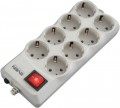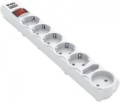Max. energy absorption
The maximum energy absorption provided by the mains filter, namely, the maximum pulse energy at which the device can safely absorb and dissipate it, completely protecting the connected load. The higher this indicator, the more reliable the filter, the more powerful power surges it can handle. In inexpensive models, the maximum absorption is calculated in tens of joules, in the most advanced models it can exceed 1000 J and even 2000 J.
Grounded sockets (type F)
The number of
sockets with type F grounding, provided in the design of the mains filter.
In this case, we are talking about full-size European type F sockets with metal ground clamps on both sides at the edges of the socket. The "socket" in this case means a CEE 7/4 ("Schuko") standard plug. Grounding is required for the safe operation of some types of electrical appliances, in particular, washing machines and other machines that work with water, refrigerators, computers, audio equipment, etc. A detailed list can be found in the reference literature. If you plan to connect such devices through the filter, this filter must have sockets with grounding.
Ungrounded sockets (type C)
The number of
sockets without earthing type C, provided in the design of the mains filter.
In this case, it is assumed that the design of the power filter has a European type C socket (or several such sockets) without grounding. In this case, a "socket" means a CEE 7/4 ("Schuko") plug with two round holes in the central plane of the socket. It is worth choosing a model with this function only if the devices that you plan to use with the filter do not require grounding - otherwise, connecting to such an outlet may be unsafe.
Compact
The number of "
compact" sockets provided in the surge protector design.
The compact plug (CEE 7/16 standard) has a flat shape and two round contacts. It is used in electrical appliances that have low power and do not create a large load — in particular, chargers for portable gadgets. At the same time, such plugs are quite compatible with full-size "sockets" of the CEE 7/4 standard. Nevertheless, in the design of surge protectors, specialized sockets of the "compact" type can be provided: they take up little space and can be placed even on the "excess" of free space, which is too small for ordinary sockets.
Note that full-size "plugs" are poorly compatible with compact sockets. Such a plug can only be connected via an adapter, while it is worth remembering that compact sockets are designed for low load power. So it makes sense to specially purchase a surge protector with compact connectors only if you initially plan to connect devices with plugs of the same type to it.
Outlets location
Options for placing sockets on the body of an extension cord or surge protector.
-
Along the hull. Devices with the layout of sockets in one slender line, which is extended along the entire body of the extension cord or surge protector.
-
In 2 rows. A popular scheme with the arrangement of sockets in 2 rows is on both sides of the upper plane of the device housing.
-
In a circle. This category includes all extension cords and surge protectors with sockets in the form of a full circle or a semicircle.
-
On both sides of the body. Sockets on several side faces of the case are found in compact cube models and in advanced surge protectors with relocated sockets on both sides of the case, which makes it easy to connect a large number of consumer devices.
Socket plugs
Placement of plugs in sockets of an extension cord or surge protector relative to the device case.
-
at an angle. Seats with holes for plugs in such models are rotated at an angle of about 45 ° relative to the plane of the case. Such an option for placing plugs allows for convenient inclusion of plugs so that they do not interfere with each other and do not overlap adjacent slots.
—
Parallel to the body (180°). The holes for the plugs in this layout are arranged in sockets parallel to the body of the extension cord or surge protector. Large plugs are included in them perpendicularly, i.e. at an angle of 90° from the side of the "tail" with a network cable in relation to the axis of the device body.
—
Perpendicular to the body (90°). A fairly rare form factor that involves the placement of seats for a plug with a plug perpendicular to the axis of the device case. As a rule, openings at an angle of 90 ° relative to the housing are found in models for compact flat plugs and in surge protectors of atypical form factor. They can also coexist with sockets where the holes for the plugs are located at an angle.
- At an angle and parallel to the body. Combined variant of the layout of the holes for the plug, combining sockets with seating at an angle and parallel to the axis of the body of the extension cord or surge protector.
- At an
...angle and perpendicular to the body. A variety of network filters and extension cords with different arrangements of holes in the mounting sockets. Most of them are placed at an angle with respect to the axis of the body, and one or more - perpendicular.
